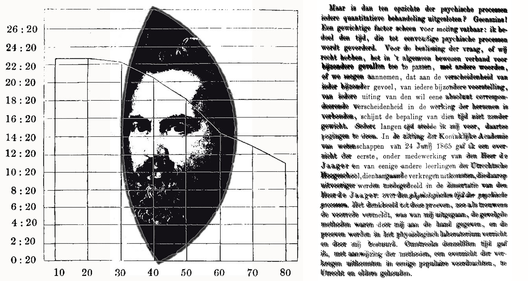Frans Cornelis Donders1818–1889
Donders was an ophthalmologist who saw beyond the eye. He introduced reaction time as a measure of mental processing. In 1865 he presented a paper to the Royal Netherlands Academy of Sciences outlining his initial experiments on timing mental processes. A more elaborate report was published in 1868, and again in 1869 (from which the text on the right, containing his portrait, is taken). Donders introduced his paper by lamenting the difficulty of applying the rigour of physiology to the study of mental processes. “But will all quantitative treatment of mental processes be out of the question? By no means! An important factor seemed to be susceptible to measurement: I refer to the time required for simple mental processes. For answering the question whether we are entitled to apply the generally proved relation to special cases - in other words, whether we may assume that there is an absolute correspondence between diverse functions in the brain and the diversity in each particular sensation, each private mental picture, each expression of the will - it seems that the determination of that duration of time is not without importance.” Donders was aware of Helmholtz’s measurements of the velocity of nerve conduction, and the durations of simple response times. “The idea occurred to me to interpose into the process of physiological time some new components of mental action. If I investigated how much time this would lengthen the physiological time, this would, I judged, reveal the time required for the interposed term.” The expression `reaction time’ was introduced in 1873 by Sigmund Exner, and Donders distinguished between various types: a-type was to single stimuli, b-type was to several stimuli, and c-type was to one but not to an alternative stimulus. Donders’ c reaction times are longer than a or b. Much of the early research in Wundt’s laboratory was concerned with confirming Donders’ extensive work on reaction times. He was trained in medicine at Utrecht and his abiding interests were in physiology. He became engaged in ophthalmology almost by accident, when he translated a book by Ruete from German to Dutch, repeating many of the experiments reported in it. He became professor of ophthalmology at the University of Utrecht in 1852. Donders wrote extensively on anomalies of refraction and accommodation, considering the latter to be a consequence of pupillary contraction. Donders’ law states that the eyes always assume the same orientation in a particular position no matter what pattern of movements were taken to reach it. On the left he is shown in his lens and also the chart of diminishing visual acuity with age. Although his main research was concerned with vision, his impact on neuroscience has been a consequence of his use of reaction time as an index of cognitive functioning. His portrait is presented in text that differs in clarity: it is intentionally difficult to accommodate to the peripheral text, while the more clearly defined central region defines Donders’ face.
